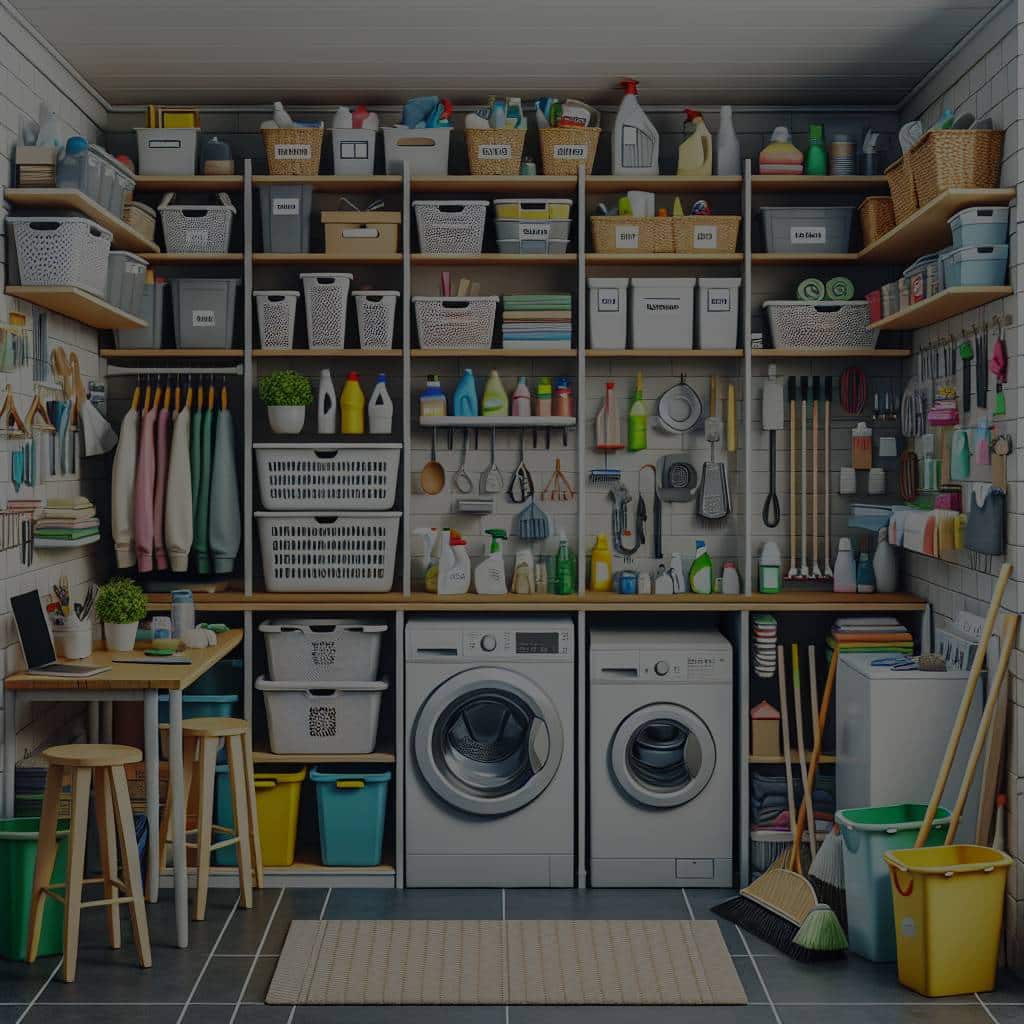The utility room is often the unsung hero of a busy household. It’s a place of multi-functionality, a room where we wash our clothes, store our cleaning items, and stow away those miscellaneous objects that don’t quite fit anywhere else. With the constant use and various functions, it’s easy for this space to quickly become cluttered and disorganized. So, how can you keep your utility room clean and tidy, ensuring it remains a functional space that supports the seamless operation of your home? In this article, we’ll share some best practices to help you transform your utility room into a well-organized, efficient space, from incorporating clever storage solutions to creating a design that complements your family’s lifestyle.
Understanding the Purpose of Your Utility Room
Before diving into storage ideas and design concepts, it’s important to understand the specific purpose your utility room will serve in your household. Does it function primarily as a laundry room, a cleaning hub, or a storage space? Maybe it’s all three. Either way, clearly identifying its purpose will help guide your organization process.
This might interest you : What’s the Best Way to Design a Space-Efficient Workstation for Telecommuting?
The utility room is an often-overlooked space in many homes. It’s not just a place to throw dirty clothes or to hide cleaning items, it’s a space that, with a little bit of thought and planning, can greatly enhance your home’s functionality. By defining what you want this space to be, you can create a room that truly meets the needs of your busy family.
Create a Functional Design
Once you’ve defined the purpose of your utility room, the next step is to create a functional design that accommodates your needs. This doesn’t mean you have to embark on a full-scale renovation project. Small, thoughtful changes can make a big difference.
This might interest you : How Can You Incorporate a Hidden Litter Box in a Modern Apartment Decor?
Create designated zones for different tasks such as laundry, cleaning supplies, and storage. If the room doubles as a laundry room, allocate one area for washing and drying clothes and another for folding and ironing. If you have a large family, consider installing a double basin sink for soaking stained clothes.
Remember, the utility room is not just a functional space, it’s also a part of your home. Choose a design that reflects your overall aesthetic and creates a pleasant environment. A fresh coat of paint, bright lighting, and decorative touches like artwork can add a welcoming feel to the room.
Implementing Storage Solutions
When it comes to keeping your utility room organized, storage is key. With the right storage solutions, you can maximize space and keep everything in its place.
Start by taking an inventory of the items you need to store. This will help you determine what type of storage will work best. For example, if you have a lot of laundry supplies, consider installing shelves or cabinets above your washer and dryer. Use storage baskets to keep smaller items organized and easy to find.
Another great storage solution is to use wall-mounted hooks or pegboards for hanging items like brooms, mops, and ironing boards. This will free up floor space and keep your cleaning tools easily accessible.
Keep it Clean and Tidy
Maintaining a clean and tidy utility room is just as important as organizing it. Make sure to regularly clear out any clutter, and give the room a deep clean at least once a month.
Remember to clean your appliances too. Regularly cleaning your washer and dryer will keep them running efficiently and can help prevent any unpleasant odors. And don’t forget to frequently empty the lint trap in your dryer, as this can pose a fire hazard if not regularly cleaned.
Regular maintenance is not just about cleanliness, it also helps to keep the space functioning effectively. Organize a family cleaning schedule to ensure everyone does their part in keeping the room clean and tidy.
Maximizing Your Space
In many homes, the utility room is not the largest room in the house. But with clever design and storage solutions, you can make the most of the space you have.
Installing wall-mounted shelves or cabinets can help to utilize vertical space. Consider using the back of the door for additional storage – a simple rack or set of hooks can provide extra hanging space for brooms, coats, or bags.
If you don’t have space for a separate laundry basket, consider a pull-out version that can be integrated into your cabinetry. This not only saves space but also keeps dirty clothes out of sight.
Remember, every utility room is different, and what works in one home may not work in another. So, tailor these tips to your specific space and needs. With a little thought and planning, you can create a utility room that is organized, functional, and a valuable addition to your busy household.
Designing a Laundry Zone
An integral component of organizing your utility room is to design an optimal laundry zone. This zone should be strategically planned around your washer and dryer, two key laundry appliances that require their own dedicated room ideas for easy accessibility and use.
If you have a top-load washer, ensure that the washer’s lid can fully open without hitting any shelves or cabinets. For front-load washers and dryers, consider building a pedestal to raise them, making it easier to load and unload clothes, and providing extra storage space beneath.
Incorporate room storage ideas like installing a small fold-down shelf or a wall-mounted drying rack for an air-dry option. This not only saves space but also helps in reducing energy consumption. A hamper or a laundry basket nearby can be a practical addition for storing dirty clothes before laundry day and keeping clean clothes after washing.
The placement of a water heater should also be considered in the design. Ensure it is easily accessible for maintenance and doesn’t interfere with the laundry process.
Remember to incorporate your aesthetic preferences to make the laundry task more enjoyable. Maybe a vibrant color on the walls, a fun poster, or even a small TV for catching up on your favorite shows while folding clothes.
Making the Most out of Your Utility Room
Beyond laundry, the utility room can serve various purposes, and each of these additional functions will require their own space and storage solutions.
For instance, if you use the utility room for storage, think vertically. Make use of the walls to install shelves or cabinets. Store items that you use frequently at eye level and the ones seldom used on the top. Use clear labeled bins for better visibility and easy access.
If you plan to use your utility room as a cleaning hub, organize your brooms, mops, and vacuum cleaner efficiently. Use wall-mounted clips or hooks to hang these items. This keeps them off the floor and makes them easy to grab when needed.
For smaller items like detergent, fabric softener, or cleaning supplies, use storage baskets or bins on the shelves. This not only keeps them organized but also prevents any spills or leaks from damaging other items.
Conclusion
In conclusion, a well-organized utility room is undoubtedly a valuable asset to any busy household. With clear identification of its purposes, thoughtful design, and clever storage ideas, this space can significantly enhance the functionality and efficiency of your home.
Remember, the utility room is meant to serve your needs, so don’t be afraid to customize it according to your preferences. Whether it’s creating a cozy laundry zone, a practical cleaning hub, or a well-organized storage area, each change you make will contribute to creating an environment that supports the seamless operation of your household.
Keeping the room clean and tidy should be a shared responsibility of all family members. Establish a regular cleaning schedule to ensure that your utility room is always in its best condition. With all these best practices in place, you can transform your utility room into a space that makes everyday chores a little bit easier.
Remember, organizing is not a one-time task but a process. So, take your time, assess your needs, and gradually make the changes. Happy organizing!






